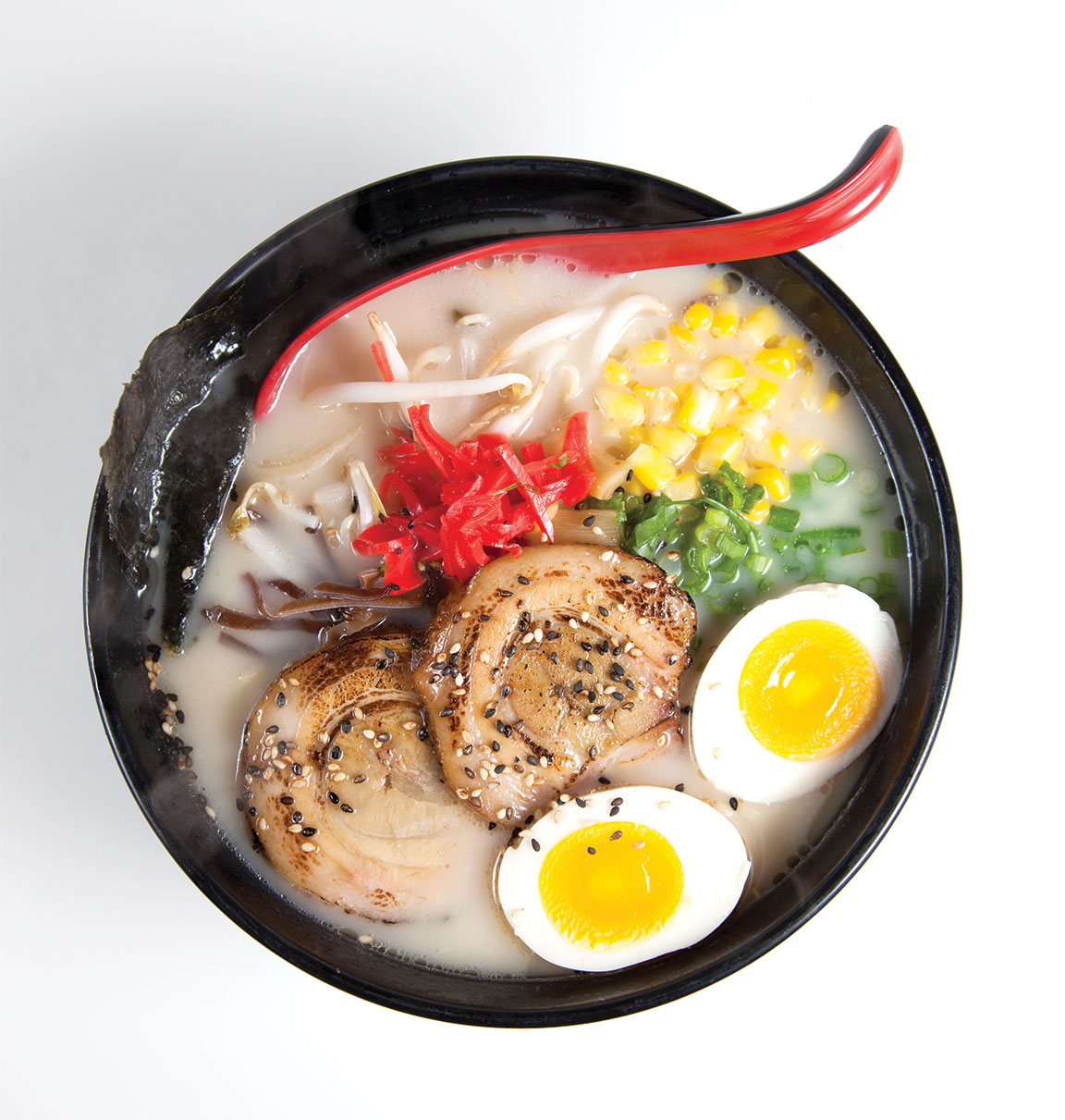Review: Midtown Sushi & Ramen
After eating here a few times, I propose reversing the order of the dishes featured in Midtown’s name. With only four options on my visits, the ramen seemed to attract the most customers, something unheard of when sushi was the defining dish of Japanese cuisine. National trends have propelled the rise of ramen, and with increased interest in noodle soups from other Asian countries like Vietnam, Korea, Thailand and Taiwan, it’s no wonder people are paying more attention to the details and subtleties of humankind’s most ingenious meal-in-a-bowl.
The sushi at Midtown Sushi & Ramen is fine – competent but mostly unremarkable, aside from the fact that it’s always nice to have a few nigiri while reading a menu or a roll to share over a couple bowls of soup. The menu also includes everyday Japanese dishes like gydon: paper-thin slices of shaved beef (think Philly cheesesteak) and slivered onions simmered in a sweet-savory-salty broth until thickened into a sauce. Served over white rice, it’s exactly the kind of simple comfort food you want after a crazy day at work.
Broth and noodles are the heart of ramen, but like pizza, the regional variations are endless. Owner Conan Sutton sticks to what he knows best: his mother Michiko Sutton’s recipes from Kyushu, the southernmost of Japan’s four main islands and home to ramen styles Nagasaki and Hakata. Sutton, a veteran of several sushi restaurants, is usually at the sushi bar, while Mom, who has her share of culinary credentials, works the soups in the open kitchen.

The best ramen was the Nagasaki champion, a heady mélange of noodles, seafood and vegetables swimming in a delicately flavored broth. Then again, there was the Hakata ramen with smoked pork belly, a custard-soft egg, bamboo shoots, mushrooms, corn kernels and bean sprouts. Kimchi ramen was a mashup of both, funked up with the spicy fermented cabbage. A bowl of plain ramen kept it simple with just noodles and eggs. Three new versions should be available by now: duck, curry and vegetarian.
Tonkotsu is the most common broth base for ramen, made by boiling pork bones until everything – fat, marrow, minerals, proteins – is emulsified into an opaque liquid that looks like light cream and has a slightly oleaginous mouth feel from the shiny droplets of fat that glisten on the lips after each delicious slurp. Sutton tames the broth’s natural intensity by adding chicken bones to the equation, producing a lighter flavor without losing its porky essence.
While the same broth united Midtown’s four ramens, key ingredients, flavoring and noodle style set them apart. That Hakata bowl, for instance, got its punch from pickled ginger and surprising extra depth of flavor from the thin discs of rolled pork belly smoked next door at Dixon’s Smoke Co. and torched to a delicate char. The Nagasaki champon is typical of that region’s Chinese-influenced noodle soups. In addition to a few clams, shrimp and vegetables (carrot, mushroom, onion, cabbage and cauliflower), the broth sang with gentle notes of garlic and sesame oil. Both variations were simple and soothing.
The soft egg noodles used in Hakata and Nagasaki bowls differ in thickness, texture and preparation: thin, squiggly, springy noodles for the former, cooked separately before the soup is poured over them; thicker, chewier noodles for the latter. Typical of all Asian noodles, both are alkaline (with baking soda added to the dough), which brings its own distinctive taste and keeps the noodles from turning to mush in hot liquid.
The inside of the fast-casual restaurant is halogen-bright with a few design elements setting it apart from the bare bones motif of most mom-and-pop Asian eateries: from the Great Wave Off Kanagawa and comical Godzilla murals to the exposed brick and snappy blonde wood chairs and tables, on which you’ll find little shakers filled with togarashi seasoning. Still, four televisions line the bar and kitchen walls, playing silently while pop radio provides the background noise for about 50 seats. With the restaurant’s newly acquired liquor license, there are three Japanese beers, Bud and Bud Light. Sake choices are limited to a couple single-serving options or a glass of boxed Sho Chiku Bai. Service is attentive and friendly with endless smiles from staff.
Situated at the eastern end of Forest Park Avenue in the former, short-lived Flying Rolls space, Midtown Sushi & Ramen sits between two other restaurants filling recent turnovers: Dixon’s Smoke Co. (previously Jimmy John’s) and Pappo’s Pizzeria & Brewery (which was Six Row Brewing Co.). It’s another example of our insatiable appetite for noodle soups and proof St. Louis has ample room for the myriad styles of ramen. Oh, and there’s sushi.
AT A GLANCE
Where
3674 Forest Park Ave., St. Louis, 314.328.2452, midtown-sushi.com
Don’t Miss Dishes
Nagasaki and Hakata ramens
Vibe
Old brick with stylish accents in an overly bright room
Entree Prices
$12 to $15
When
Tue. to Fri. – 11:30 a.m. to 3 p.m.; 5 to 9:30 p.m., Sat. – 11:30 a.m. to 9:30 p.m., Sun. – noon to 8 p.m.
Tags : Places, Reviews, Restaurants






